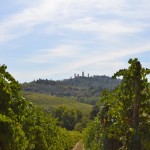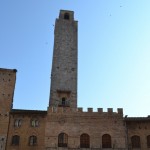 I first discovered the wines of Vernaccia di San Gimignano when on vacation in Florence back in 2001. This crisp, white wine was a perfect accompaniment to the wonderful food we ate. And, on a day trip to Siena, we made a brief stop in the “medieval Manhattan” before returning to Florence. The one hour in which we scampered around the walled town, with its imposing towers, and stumbled upon an olive oil festival, reinforced our fascination with this tiny village and cemented its image into my memory. Ten years later, I found myself back in Tuscany wondering if the magic would still be there.
I first discovered the wines of Vernaccia di San Gimignano when on vacation in Florence back in 2001. This crisp, white wine was a perfect accompaniment to the wonderful food we ate. And, on a day trip to Siena, we made a brief stop in the “medieval Manhattan” before returning to Florence. The one hour in which we scampered around the walled town, with its imposing towers, and stumbled upon an olive oil festival, reinforced our fascination with this tiny village and cemented its image into my memory. Ten years later, I found myself back in Tuscany wondering if the magic would still be there.
On our first evening in Siena, the first course of zucchini blossoms stuffed with ricotta cheese was paired with two Vernaccias. In tasting them, I discovered something interesting – the second of the two wines was showing some development. I enjoyed the aged characteristics of this wine, pleasantly surprised that these wines had the ability to mature with time in the bottle. This was a new side to this wine, further capturing my attention.
When we finally arrived in San Gimignano a few days later, I held my breath, convinced that my fond memories of this town had been overblown in my mind with the passage of time. Yet, as we rounded the corner, I could see the city walls and its towers overhead and my heart leapt. I was still in awe.
After a guided tour through the city, we arrived at the Museo de Vino where we were given a proper introduction to the wine, complete with a visit from San Gimignano’s mayor. The indigenous Vernaccia grape is quite ancient, with historical evidence of its existence dating to the 13th century with literary mentions of it found in Dante’s Divine Comedy. However, despite this illustrious past, the grape fell out of favor until after the World War II. 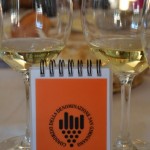
But, the grape and its wine were soon resurrected with the Vernaccia di San Gimignano appellation becoming the first to earn Denominazione di Origine Controllata (DOC) status in 1966 with a promotion to DOCG in 1993. It holds the additional distinction of being one of the only white wines within Italy to include a Riserva designation. Wines labeled as such have undergone an aging period of at least 24 months, of which a portion must be spent in oak.
While many tourists become familiar with this wine on holiday in the area (as did I), this has served as a double-edged sword for the appellation in that much of the wine consumed in this manner was of lesser quality, marring the reputation of Vernaccia di San Gimignano. Today, this is changing as producers have shifted their focus toward improving the quality of their wines, which was evident in the tasting conducted at the Museo. And, lest you think that the tasting was fixed, we were given the opportunity to taste through over 40 wines. Moreover, the Consorzio is giving careful consideration to its appellation laws, having recently developed a list of forbidden grapes for the 10% or less of the blend that is permitted (a minimum of 90% Vernaccia is required).
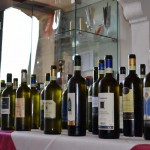 On its own, Vernaccia di San Gimignano characteristically offers up notes of alomnd, mineral and earth, which can evolve with bottle age. Also, similarly to Chardonnay, the grape’s non-aromatic nature takes well to oak treatment, yielding additional complexity to the resulting wines. The best examples showed a range of aromas and flavors from floral and herbal tea to lime, minerality and spice.
On its own, Vernaccia di San Gimignano characteristically offers up notes of alomnd, mineral and earth, which can evolve with bottle age. Also, similarly to Chardonnay, the grape’s non-aromatic nature takes well to oak treatment, yielding additional complexity to the resulting wines. The best examples showed a range of aromas and flavors from floral and herbal tea to lime, minerality and spice.
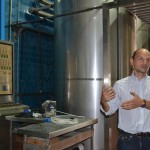 Within the region, there are a wide range of producers, most of which are family run and relatively small in size. The exception to this rule is Teruzzi & Puthod, which was initially established by Mr. Teruzzi, but is now owned by Gruppo Campari and is among the largest and most modern in the area. Here, the vast size of the production has permitted the winery to make significant investments in state-of-the-art technology from unique fermentation vats to an extremely sophisticated bottling line.
Within the region, there are a wide range of producers, most of which are family run and relatively small in size. The exception to this rule is Teruzzi & Puthod, which was initially established by Mr. Teruzzi, but is now owned by Gruppo Campari and is among the largest and most modern in the area. Here, the vast size of the production has permitted the winery to make significant investments in state-of-the-art technology from unique fermentation vats to an extremely sophisticated bottling line.
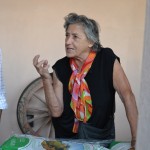 At Montenidoli, Maria Elisabetta Fagiuoli is at the helm, having bought the land with money from her grandmother, an unusually independent move at the time. Whereas Maria Elizabetta’s husband Sergio is a poet by profession, Maria herself is a bit of a philosopher. She was quick to advise us that, “I am not a winemaker. I am a nurse of the land; the earth is the winemaker,” and also quipped, “Wine and people are the same; they get better with age or become vinegar.” Her wines are deserving of such meditative thoughts as they too give the taster pause in their depth and elegance.
At Montenidoli, Maria Elisabetta Fagiuoli is at the helm, having bought the land with money from her grandmother, an unusually independent move at the time. Whereas Maria Elizabetta’s husband Sergio is a poet by profession, Maria herself is a bit of a philosopher. She was quick to advise us that, “I am not a winemaker. I am a nurse of the land; the earth is the winemaker,” and also quipped, “Wine and people are the same; they get better with age or become vinegar.” Her wines are deserving of such meditative thoughts as they too give the taster pause in their depth and elegance.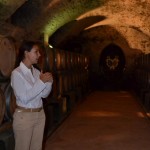
The region is not without its royalty, with Tenute Guicciardini Strozzi owned by Count Robert Guicciardini and Prince Girolamo Strozzi. Prince Strozzi’s daughters, Princesses Natalia and Irina, are the 15th generation direct descendants to Lisa Gherardini del Giocondo, the actual Mona Lisa. Although the company owns several estates, its Vernaccia production takes place at the 530 ha estate at Villa Cusona, which dates to 994 and has been home to winemaking since the 1200s.
Although less regal in its heritage, a visit to Poderi del Paradiso is truly a visit to paradise with its sweeping vistas of beautiful vineyards presided over by San Gimignano’s towers. Owned by the Cetti family, who originally came to San Gimignano as serfs in the Middle Ages, the family rose to prominence and wealth in only two generations. The current generation acquired Poderi del Paradiso in 1973.
With its storied history, Vernaccia di San Gimignano is steeped in Italy’s tradition, but, with producers’ renewed emphasis on quality, the appellation is also poised to produce great wines now and in the future…with hard work, dedication and perhaps, a bit of medieval magic.
TASTING NOTES
Montenidoli Carato Riserva 2007, Vernaccia di San Gimignano, Italy
A complex nose of floral, chamomile tea, tidal pool and a hint of butterscotch gives way to spice, mineral and savory characteristics on the full-bodied, dry palate and culminates in long length.
Poderi del Paradiso Biscondola 2010, Vernaccia di San Gimignano, Italy
Produced from a single vineyard, the grapes were picked two weeks later than those for its base wine. Almond, floral, lime greeted the nose and persisted on the dry palate, joined by concentrated flavors of apple peel and minerality.
Tenute Guicciardini Strozzi 2010, Vernaccia di San Gimignano, Italy
With floral, mineral and citrus pith aromas, this wine has a dry palate and offered typical bitter almond notes in its long finish.
Tenuta Le Calcinaie 2010, Vernaccia di San Gimignano, Italy
From an organic producer, this wine has floral, tidal pool, mineral and lime aromas, with juicy lime and minerality on the dry palate. The rush to pick early after a rainy summer resulted in brighter acidity than usual, adding to the austerity of this wine and its clean finish.
Teruzzi & Puthod Rondolino 2010, Vernaccia di San Gimignano, Italy
Notes of floral, almond and citrus showed on both the nose and palate, with a slight nuttiness lingering in the long length.
NB: Although not strictly of the Vernaccia di San Gimignano appellation, Montenidoli’s Il Templar and Teruzzi & Puthod’s Terre di Tufi (both Vernaccia blends, labeled as IGT Toscana) are worth seeking out as well. The former wine has significant staying power with a tasting of the 1999 not belying its age. In a mini-vertical tasting of Terre di Tufi 2007, 2008 and 2009, my preference was for the 2008.

